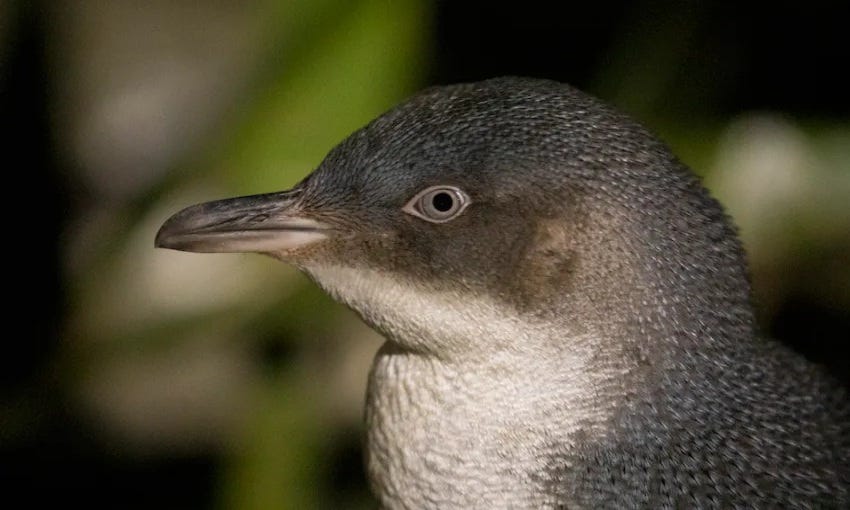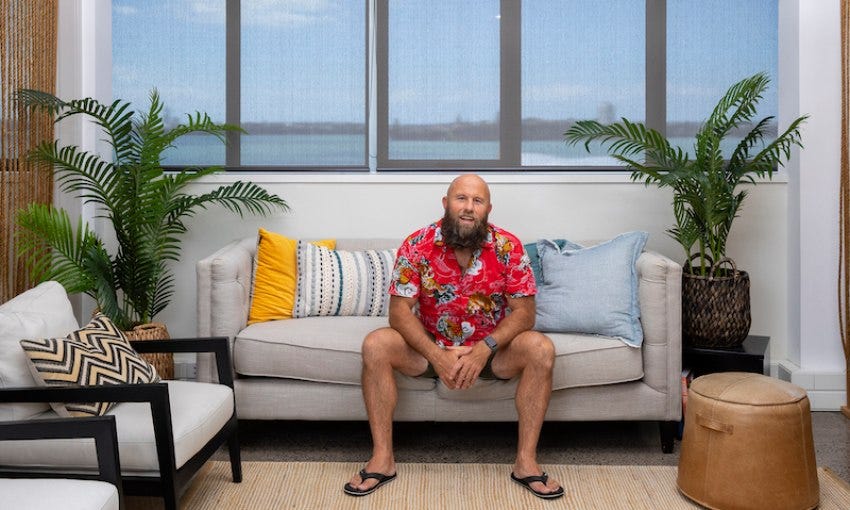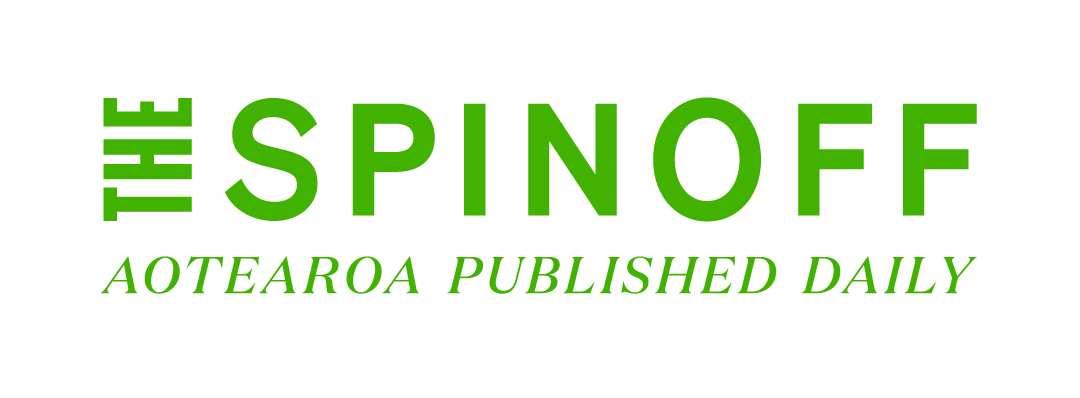The tiniest penguins and the people who care for them
The kororā of Leigh might prefer the rock crevices but they also have the option of nesting in boxes painted by local school kids with a sign reading “Penguins only” emblazoned across them
Kia ora! Welcome to the very first instalment of Future Proof, brought to you by Electric Kiwi.
Future Proof is a weekly newsletter from The Spinoff where we take a hopeful but honest dive into what’s happening in the environment. I’m science writer Ellen Rykers, and I’m stoked to be here in your inbox, delivering a curated selection of the environmental stories you need to know about. Thanks for joining me on this journey.
The kororā are the world’s smallest penguins. (Photo by Sanka Vidanagama/NurPhoto via Getty Images)
Last week, I braved the wild wet to visit some penguins. In fact, the world’s teeniest penguin species, found right here in Aotearoa, the kororā. You might remember them from that time they had to be escorted by police from a Wellington sushi shop for causing a ruckus.
The plight of our kororā has been in the spotlight recently, with hundreds of penguins washing up dead on Northland beaches, and others evicted from their rocky homes on Waiheke Island to make way for a giant marina that it seems few on Waiheke really want. The particular penguins I’d hoped to meet live just down the road from me: along the rugged rocky coastline around the fishing village of Leigh, about an hour and a half north of Auckland. Unfortunately, they were all out at sea during the day I visited, hunting for kaimoana. But I did meet an absolutely top bloke, Neil, who is part of a small group of locals trying to help our waddling neighbours.
The group does predator trapping, has put up signs to let dog owners know to keep their pups on leash, and has provided the penguins with bespoke nest boxes. Of course, the penguins seem to prefer their homes either au naturel, in rocky crevices or deep caves, or positively opulent, in people’s garden sheds or under their houses. The nest boxes are adorable though, with some painted in bright colours by local schoolkids and emblazoned with ‘PENGUINS ONLY’.
Neil proudly showed me the odd nest box which had attracted regular occupants, and pointed out the rugged terrain he’s traversed to map out tens of natural burrows along the cliffs.
This visit reminded me why I love writing stories about the environment and science. Yes, the animals are cool. But really, it’s the passionate, quirky, interesting people who I get to meet that are eager to share their enthusiasm and knowledge.
Read the rest of this piece about what Future Proof will deliver for readers and why I’m excited about it on The Spinoff.
Rakiura Stewart Island to be rid of several invasive predator species
Predator Free Rakiura is joining forces with crown research institute Manaaki Whenua to eradicate possums, rats, feral cats and hedgehogs from Rakiura as part of a 4-year, $2.8m research programme. This is BIG news: if successful, this would be our biggest island eradication yet, and the world’s first on a permanently inhabited island (plus, it’d be an important step towards NZ’s lofty predator-free 2050 aspirations). It’s awesome to see feral cats and hedgehogs included – both species are absent from national predator-free goals, but are threats to native wildlife. It would be even better to see deer included too: out-of-control deer decimate native bush, and Rakiura deer have been observed eating the eggs of critically endangered southern New Zealand dotterels. But with cats, rats and possums goneburger, the chonky, charismatic kākāpō could make a safe return to Rakiura, according to scientist Dr Andrew Digby. (In other kākāpō news, the population has just jumped up to 211, as the latest lot of juveniles is now old enough to add to the official population count.)
Climate change commission releases thoughts on He Waka Eke Noa
This plan, which must be set in stone by 2025, would sit outside the Emissions Trading Scheme (ETS) that prices greenhouse gas emissions for everyone else. Newsroom’s Marc Daalder has a handy analysis of the commission’s recommendations and criticisms, which include pointing out that the industry’s 10% methane reduction target appears to rely on tech that’s not yet available. While there’s clearly some work to do on an emissions pricing plan, there are plenty of farmers already taking the lead on climate and biodiversity. North Island farmer Dan Steele of Blue Duck Station says, “As New Zealand’s biggest landowners we have got to lead the conservation movement. I think you’ve got to be a conservationist if you want a better world, and that means being a greenie.”
Companies will need to disclose emissions
Next year, some companies will have to disclose their emissions and report on how climate change might pose a risk to their businesses. Analysts reckon these rules will be a game-changer, helping to funnel investor money away from environment-damaging businesses. The details of these new rules, passed in October last year, are being hashed out right now – but there are a few road bumps. Stuff’s Eloise Gibson has a useful explainer, including details on which companies will have to fess up to their climate situation and which won’t.
Matching projects to businesses in biodiversity units scheme
Speaking of sustainable business, you can now purchase “biodiversity units” (just like climate credits) through a local market established by environmental financing business Ekos. The platform matches businesses with conservation projects requiring funding, and each “unit” purchased measures short-term biodiversity outcomes, like low pest or weed numbers.
Meet the new chief executive of Forest & Bird
Nicola Toki is the new chief executive of Forest & Bird and has been profiled by the Dominion Post’s Kate Green. I regularly work with Nicola and subbed in for her on RNZ’s Critter of the Week last week. I think Green has done a stellar job showcasing Nicola’s drive, and I can’t go past this ever-salient whakataukī: Kia kore e rite ki te moa | Don’t let anything else go the way of the moa.
Luke Blincoe
Looking after people and planet
This week I had a chat with father of four, surfer and CEO of Electric Kiwi, Luke Blincoe.
The brainchild of three high school mates from Whakatāne – Julian, Phillip and Huia – Electric Kiwi was established in 2014. Since then, they’ve been innovating with tech-driven initiatives like the Hour of Power, and composing earworm jingles.
What’s the purpose and vision behind Electric Kiwi?
The three founders were chatting at a barbecue and came to the conclusion that we could give Kiwis much better value in electricity retailing AND a way to make a contribution to decarbonisation through their electricity usage.
The purpose today is to make things better for our people, the planet and our customers. That gives us a really strong drive to look after our people, make the planet a better place to be, and allow customers to actually impact that.
How does Electric Kiwi enable customers to reduce their carbon footprint?
The amazing thing is you can reduce your carbon footprint and pay less. Our foundation was the Hour of Power: one hour of free, off-peak power every day. That's what we call a load-shifting product, so it encourages customers to move their consumption to off-peak periods when it's far less likely that fossil fuels will be burning.
More recently, we've launched a product called MoveMaster, which is half-price nights. It’s the same concept as Hour of Power, but thinking ahead to things like electric vehicles where people might want to charge overnight.
We're also certified carbon neutral, but we don't really talk about that because it doesn't help consumers change their carbon footprint. There's lots of greenwashing with companies saying “we're carbon neutral because we buy these offsets”. We're not big fans of that offset game. We're more about, how do you change your behaviour to reduce emissions, not just clear your conscience by buying some offsets? That's a big driver for us: enabling consumers to make an actual contribution.
What makes Electric Kiwi a truly “Kiwi” brand?
Authenticity is really important to me personally. I think we’re pretty well known for having robust engagement with regulators – we’re here to stand up for our customers and we’re not afraid of saying what we think.
Kiwis love the underdog. We’re a small company in the scheme of electricity and we really fight hard and try to punch above our weight. That’s something I think Kiwis really resonate with.
Finally, the jingle. Give me the goss – where did that come from?
There's some footage, that may never be released, of the team at about midnight after our Christmas party singing this song that our marketing team had penned. It was never really supposed to be an ad until Covid came along and everyone was locked down. Andy in the marketing team went around and recorded all of our staff singing it at our own homes and put it all together.
And then, he said, “It’s actually come out quite good, and media is really cheap at the moment…”. I said, “Ohh mate, you wouldn't, you couldn't put that on TV, could ya!?” And so we did. And it was incredibly successful for the very reason that it was somewhat lowbrow and self-deprecating. People just loved the fact that it was us being us, having a laugh at ourselves at a time when there was more than enough bad news going around.
Some of us can never forget it. We won’t be allowed to.
Electric Kiwi are the awesome founding partners of Future Proof, and they’re offering the chance to win a year of free power* if you sign up. Tell your friends and whānau! *Full promotion T+Cs here.
To finish off, a little perspective. When astronauts go to space, some experience a profound shift in attitude towards the little blue planet we call home, dubbed the “overview effect”. It arises from seeing Earth from above, where boundaries between nations, people and species disappear. In that spirit, here are gorgeous true-colour images of our special corner of the South Pacific captured by the European Space Agency in August 2018. Look at the vibrant forest greens! The snow-capped Southern Alps! What a bloody beautiful place to call home.
Got some feedback about Future Proof or topics you’d like covered? Get in touch with me at futureproof@thespinoff.co.nz


















Kia ora Ellen thanks for these links! I despair at how much environmental reporting I miss since I’m not on socials and tend not to visit news sites directly. I’ve often thought that we need a cross media approach to covering climate.... Awesome to know that if I can just make sure I read this newsletter/digest I will have a good shot at being across the key issues!